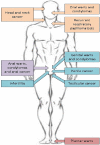HPV-related diseases in male patients: an underestimated conundrum
- PMID: 37770654
- PMCID: PMC10859347
- DOI: 10.1007/s40618-023-02192-3
HPV-related diseases in male patients: an underestimated conundrum
Abstract
Purpose: Human papillomavirus (HPV) infection is the most common sexually transmitted disease, in males and females worldwide. While the role of HPV in female diseases is well known and largely studied, males have negligibly been included in these programs, also because the proportion of women suffering and dying from HPV-related diseases is much larger than men. The aim of this review is to focus on HPV-related diseases in male patients.
Methods: We performed a literature analysis on the electronic database PubMed. We considered randomized trials, observational and retrospective studies, original articles having as topic the relationship between HPV male infection and the following items: oral, anal penile cancers, warts, condylomas, male infertility, altered sperm parameters, anti-sperm antibodies (ASA). We also included experimental in vitro studies focused on the effects of HPV infection on oocyte fertilization, blastocyst development, and trophoblastic cell invasiveness. In addition, studies describing the adjuvant administration of the HPV vaccination as a possible strategy to promote HPV clearance from semen in infected males were included.
Results: Regarding head and neck HPV-related diseases, the most important non-neoplastic disease is recurrent respiratory papillomatosis (RRP). Regarding neoplastic diseases, the proportion of head and neck cancers attributable to HPV has increased dramatically worldwide. In addition, nowadays, it is thought that half of head and neck squamous cell carcinomas (HNSCCs) cases in the United States are caused by infection with high-risk HPV. HPV is noteworthy in andrological practice too. It was described as having a high HPV prevalence, ranging between 50 and 70%, in male penile shaft, glans penis/coronal sulcus, semen as well as in scrotal, perianal, and anal regions. Moreover, in male patients, HPV infection has been associated, among other diseases, with penile cancers. HPV semen infection has been reported in about 10% in men from the general population and about 16% in men with unexplained infertility, although these data seem widely underestimated according to clinical experience. In particular, HPV semen infection seems to be most related to asthenozoospermia and to anti-sperm antibodies (ASAs).
Conclusions: HPV infection represents a health problem with a detrimental social and public impact. Despite this evidence, little has been done to date to widely promote vaccination among young males.
Keywords: HPV; HPV-related diseases; Head and neck cancer; Male HPV; Male infertility; Sperm parameters.
© 2023. The Author(s).
Conflict of interest statement
The authors certify that they have no affiliations with or involvement in any organization or entity with any financial interest (such as honoraria; educational grants; participation in speakers’ bureaus; membership, employment, consultancies, stock ownership, or other equity interest; and expert testimony or patent-licensing arrangements), or non-financial interest (such as personal or professional relationships, affiliations, knowledge or beliefs) in the subject matter or materials discussed in this manuscript.
Figures
Similar articles
-
Human papilloma virus and genitourinary cancers: a narrative review.Minerva Urol Nefrol. 2018 Dec;70(6):579-587. doi: 10.23736/S0393-2249.18.03141-7. Epub 2018 Aug 29. Minerva Urol Nefrol. 2018. PMID: 30160386 Review.
-
The role of human papillomavirus on sperm function.Curr Opin Obstet Gynecol. 2011 Aug;23(4):232-7. doi: 10.1097/GCO.0b013e328348a3a4. Curr Opin Obstet Gynecol. 2011. PMID: 21666465 Review.
-
Association, prevalence, and clearance of human papillomavirus and antisperm antibodies in infected semen samples from infertile patients.Fertil Steril. 2013 Jan;99(1):125-131.e2. doi: 10.1016/j.fertnstert.2012.09.006. Epub 2012 Oct 6. Fertil Steril. 2013. PMID: 23043686
-
Estimation of the epidemiological burden of human papillomavirus-related cancers and non-malignant diseases in men in Europe: a review.BMC Cancer. 2012 Jan 20;12:30. doi: 10.1186/1471-2407-12-30. BMC Cancer. 2012. PMID: 22260541 Free PMC article. Review.
-
Human papillomavirus prevalence and type distribution in male anogenital sites and semen.Cancer Epidemiol Biomarkers Prev. 2007 Jun;16(6):1107-14. doi: 10.1158/1055-9965.EPI-06-0997. Cancer Epidemiol Biomarkers Prev. 2007. PMID: 17548671
Cited by
-
Prevalence and concordance of penile, anal, and oral human papillomavirus infections among sexually active heterosexual men in Ibadan, Nigeria.Cancer Causes Control. 2025 Jan;36(1):51-66. doi: 10.1007/s10552-024-01920-1. Epub 2024 Oct 3. Cancer Causes Control. 2025. PMID: 39361165
-
The role of lipids and lipids lowering drugs in human papillomavirus (HPV) and HPV-associated cancers.Infect Agent Cancer. 2025 Jan 28;20(1):4. doi: 10.1186/s13027-025-00635-5. Infect Agent Cancer. 2025. PMID: 39876011 Free PMC article. Review.
-
Prevailing of HPV-16 and 52 genotype in 2022-2023 in Sanandaj, Iran.Virol J. 2024 May 7;21(1):106. doi: 10.1186/s12985-024-02373-3. Virol J. 2024. PMID: 38715018 Free PMC article.
-
An Assessment of Young Adults' Awareness and Knowledge Related to the Human Papillomavirus (HPV), Oropharyngeal Cancer, and the HPV Vaccine.Cancers (Basel). 2025 Jan 21;17(3):344. doi: 10.3390/cancers17030344. Cancers (Basel). 2025. PMID: 39941716 Free PMC article.
-
Visual clues - dermatological manifestations of sexually transmitted infections in men.Nat Rev Urol. 2025 Aug 13. doi: 10.1038/s41585-025-01071-1. Online ahead of print. Nat Rev Urol. 2025. PMID: 40804205 Review.
References
Publication types
MeSH terms
Substances
LinkOut - more resources
Full Text Sources



